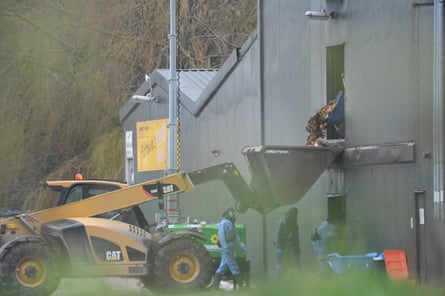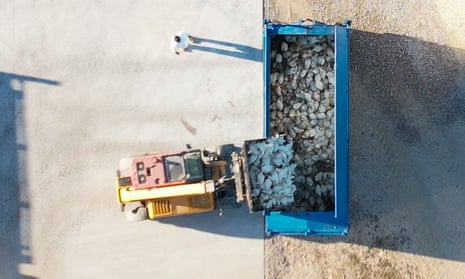More than 140 million birds have died and hundreds of millions of pounds have been spent in the past year in the US, UK and EU in tackling bird flu, as some experts said continual culling was “morally” wrong.
With an international agreement on the use of vaccinations likely to be one or two years away, the situation will probably worsen this winter as outbreaks of bird flu continue to rise.
Globally, the disease – and related culling – has killed 140 million poultry since October 2021, according to the World Organisation for Animal Health. This includes almost 48 million birds in Europe and the UK combined and just over 53 million in the US.
“If an industry can only remain by culling millions of animals it is not sustainable,” said Arjan Stegeman, professor of veterinary medicine and epidemiologist at Utrecht University in the Netherlands. Stegeman fears the next bird flu season may again be severe, suggesting culling will continue – and there are similar concerns in the UK and US.
Dr Christine Middlemiss, the UK’s chief veterinary officer, said: “We are seeing a growing number of bird flu cases. Unfortunately, we expect the number of cases to continue to rise over the coming months.”
The US Department of Agriculture (USDA) said although it “cannot predict exactly what we will see in the coming months or years … we believe it’s important for people to plan for an elevated [avian flu] risk”.
Costs and compensation in the US for this year’s outbreak total almost $570m (£465m), the USDA said. An EU source, who preferred not to be named, said: “According to the information provided, member states have spent about €440m (£380m) to combat avian influenza outbreaks.”
Responding to a recent parliamentary question Defra said £2.48m has been paid to compensate for healthy birds culled due to avian flu since 1 October 2022. No compensation is paid for birds who get sick or die from avian flu. At least 4 million birds in the UK have been culled or died from bird flu during this outbreak.

Protecting poultry by keeping them indoors and culling sick flocks are now the main bird flu control methods. Neither the USDA, EU or the UK government answered questions about the acceptability or morality of mass culling as a disease management tool.
“It is becoming almost normalised now that millions of birds are being culled, which is plain wrong,” said Dan Crossley, executive director of the the Food Ethics Council.
Stegeman said the current scale of culling was “unethical”, but that culling was currently unavoidable because avian flu “is really lethal for the flocks and 99% are going to die anyway”.
Culling, however, will not stop the spread, he said. “Twenty years ago, culling for avian flu was acceptable because it was rare and it made sense to cull birds because you also stopped the virus. Now we have the disease in wild birds so you can cull, but that’s not going to help stop the spread of the virus.
“This is a human-made problem that has arisen in south-east Asia because the H5N1 avian flu virus was not controlled properly. It started in 1996 in China, where the duck and poultry [sector] expanded rapidly, and then it spilled over to wild birds.”
According to Dr Steven McCulloch, a senior lecturer in human-animal studies at the University of Winchester, the muted nature of public concern was probably due to “a lack of knowledge and awareness” of the scale of culls, and a lack of visibility because “compared to the burning pyres of cattle we had with the foot-and-mouth outbreak in 2001”, the birds are kept in sheds.
The president of the British Veterinary Association, Malcolm Morley, said culling was only acceptable because influenzas “don’t tend to become endemic [achieve constant presence in a community]; we tend to get outbreaks and then they die off”.
In Italy, footage of a mass cull posted on the YouTube channel of animal charity Essere Animali appeared to show a botched operation in which live chickens were moved by digger into a container, before gases such as CO2, argon or nitrogen were added.
“The right method would be to fill the container with gas first then put the chickens in, so they die in a few seconds,” said Francesco Ceccarelli, the charity’s investigations director.
Containerised gassing is one of the UK’s preferred culling options, along with whole-house gassing.
Richard Webby, a virologist at St Jude Children’s Research hospital who studies influenza in birds and other animals, said that although culls are a standard response in many countries, they were not “the moral way forward” in a context where bird flu is “endemic in wild birds now”.
Both Webby and Stegeman believe vaccines are needed, but they are controversial. “We are not going to get rid of H5 [bird flu] by vaccination, but it will reduce the scale of the culling, we hope,” said Webby.

Vaccination trials on commercial poultry are now under way in Europe, but there are, as yet, no international agreements on their use. The European Commission said it had asked the European Food Safety Authority to issue a new scientific opinion on vaccination against bird flu, which is expected to be available after summer 2023.
The chicken industry is wary of trade restrictions damaging the poultry trade and suggest getting agreement on the use of vaccinations could take up to two years.
The UK government said despite vaccines’ ability to reduce mortality, disadvantages include the possibility of some vaccinated birds transmitting the disease without showing signs of sickness, making it harder to detect and eradicate the virus.
The USDA said: “At this time [vaccines] would have detrimental impacts on poultry trade while still necessitating response activities such as quarantine, depopulation, and surveillance testing.”
You can send us your stories and thoughts at animalsfarmed@theguardian.com
